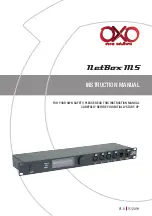
16
user manual LokSound / LokSoundXL V3, 1st edition, 07/2004
4.2 Digital operation
4.2.1 Using Märklin® 6021
LokSound decoders may be used with all Märklin®
control devices or compatible systems. The functions
F1 to F4, however, can only be activated with the
„new Motorola® format“. To activate this format
put DIP switch 2 of the 6021 to the upper („On“)
position.
XXX
4.2.2 Using DCC (Lenz, Intellibox, etc)
LokSound may be operated with any DCC compatible
system. The automatic speed step detection was tested
with the following command stations: Roco® Lok-
maus2, Uhlenbrock® Intellibox, Lenz digital plus
version 3.0, Zimo MX1. When using Lenz digital plus
version 3.0 the auto-detect function does not work
with 14 speed steps. Set 28/128 speed steps at all
times. The auto-detect function is activated every time
the decoder receives power (when turning on power
to the layout) or when you switch on the headlights.
During this process the headlights have to be switched
on and you have to turn the control knob (or slide
control) until the lights burn steadily. Should you
change the speed step setting during operation you
have to interrupt power to the decoder shortly in
order to re-activate the auto-detect function.
4.3 Resetting to factory pre-set values
You may reprogram the factory pre-set values at any
time. Write value 08 in CV 08. A reset of the sound
files is only possible with the aid of the LokProgrammer
53450.
5. Adjusting decoder parameters
Chapter 5 provides information on how to change
the settings of LokSound decoders. Please take your
time to read and understand the somewhat complex
explanations. After the introduction into the world
of decoder parameters (called CVs) in chapter 5.1,
you will find in chapter 5.2 all you want to know
about which CVs have what kind of effect on the
properties of LokSound decoders.
Chapter 5.3 explains how CVs may be set with various
DCC command stations as well as the Märklin®
command stations. You find a complete list of all CVs
in chapter 7.1.
5.1 CVs of LokSound decoders
LokSound decoders are compatible with the NRMA /
DCC standard. That means, that all parameters
controlling the properties of LokSound decoders, are
stored in so called CVs (Configuration Variables).
LokSound decoders support 230 variables. This large
number of CVs indicates the multitude of possibilities
available with LokSound decoders. In order to get the
best out of your decoder and to easily manage this
large number of settings we recommend the use of
our LokProgrammer, part no. 53450.
With LokProgrammer all CVs may be programmed
easily and comfortably on your PC. Please note that
CVs that are not programmed properly could impede
the performance of the decoder. The LokProgrammer
part no. 50450 is not suitable for programming this
decoder.
All CVs may be programmed without the
LokProgrammer by using any DCC system that is NMRA
/ DCC compatible or with Märklin® 6021.
Chapter 5.3 explains, how it works.
In each CV values from 0 to 255 may be stored.
The properties of the decoder vary depending on the
stored value. If you have a look at the list of CVs in
chapter 7.1 you will notice that most CVs have
numerical values.
For example CV 1 contains the engine address. This
may vary between 1 and 127 (see range of values).
The factory setting is 3.
Please note that not all CVs have factory pre-set values:
Some CV values vary depending on the type of sound
effect. While most CVs expect numerical values, others
represent storage locations that manage various
functions simultaneously (mostly switching on or off).
CVs 29 and 49 are good examples: for these CVs the
value has to be calculated individually, depending on
the parameters you want to adjust:
First you decide which options should to be turned
on or off. In the column „value“ you find 2 numbers
for each option. The value 0 indicates the option is
switched off, otherwise the value may range from 1
to 128. Add all values of the individual options to get
the total value to be written into the CV.
change parameters
















































